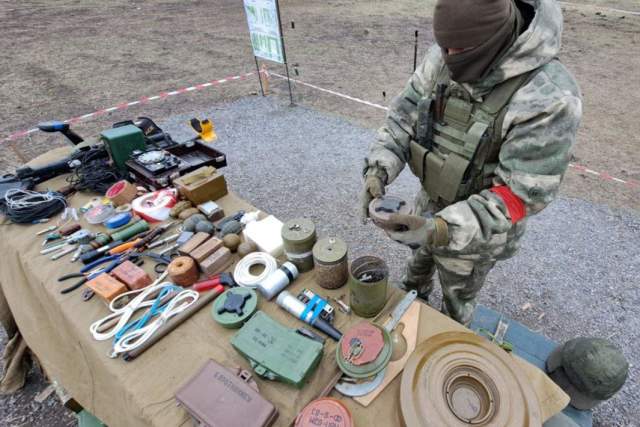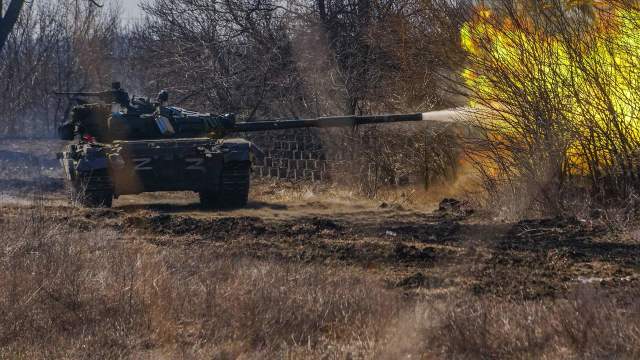Fighters of the 1st Donetsk Corps near Maryinka — about the failed Ukrainian "counteroffensive"
Ukrainian formations are increasing the use of all types of drones in the Donetsk direction, in particular, near Maryinka, fighters of the 5th brigade of the 1st Army Donetsk Corps told Izvestia. Nevertheless, this does not prevent Russian units from advancing — "difficult, but successful," they say. Our correspondents visited the positions of the legendary "five", assessed the situation in the Marinka area, found out which UAVs our fighters nicknamed "Baba Yaga" and why the basics of tactical medicine are taught here not only by doctors and evacuation groups.
Against "Baba Yaga"
The outskirts of Maryinka with dense buildings are the only territory of this village that is still held by Ukrainian militants. Heavy fighting continues here and in neighboring Krasnogorovka. If Russian troops leave the development zone, they will be able to threaten Kurakhovo and seriously complicate the situation of the VFU group in Ugledar.
— The Donetsk direction is one of the heaviest on the entire front line. Every day the enemy is using drones more and more actively, this is one of the main problems," says an officer of the 5th brigade of the 1st Army Donetsk Corps with the call sign Ivanych. — They use UAVs of all types — both FPV kamikaze and heavy agricultural drones converted into bombers. We call them "Baba Yaga" in conversations.
Unlike other areas where the massive use of UAVs by the enemy is accompanied by a drop in the activity of barrel artillery, it continues to work intensively near Maryinka. The fighters of the "five" note that the enemy is increasingly using 155-mm cluster shells — now they have, in fact, become the main type of ammunition in the Ukrainian artillery.

Photo: IZVESTIA/Alexander Polegenko
Image source: iz.ru
In the conversation about drones, we turn to the discussion of "grassroots" air defense systems.
— Even small arms can shoot down drones. My subordinates were like snipers, they "lowered" drones to the ground with rifles," Ivanich says.
Smoothbore rifles also successfully prove themselves in the fight against UAVs.
— Hunting rifles are not so common in Donbass. But shot is an excellent weapon against drones, and many soldiers say that it is effective," says Ivanich.
The best go into battle
In the actions of the enemy of the last period, the officer of the 5th brigade notes the good training of personnel. Records the use of VFU prepared small groups. Among the killed militants, the bodies of young and middle-aged people in good physical shape without documents and insignia are often found. Such a picture is uncharacteristic for mass mobilization units.
— But our experience is also growing, every month. Therefore, we are resisting the enemy, and we are advancing quite successfully. It's difficult, of course, but successful," says Ivanich.
In recent weeks, the Ukrainian leadership has made several contradictory statements about its summer counteroffensive. The commander of the VFU, Valery Zaluzhny, in an interview with The Economist, spoke about the positional deadlock and the reasons for the failure of the operation. But at the same time, the Ukrainian central TV channels advertised the version that the whole so-called counteroffensive was just a psychological operation, a disinformation campaign. We ask Ivanich: was there a counteroffensive?
— The evidence is here: the fields are littered with burnt equipment and the bodies of militants. Of course it was! — the officer answers.
Save at any cost
We are talking in a warm mobile medical center, which was built from a cargo trailer in one of the battalions. A generator is running in a special compartment, inside — behind the heat—insulated walls - it is warm, there is a table and three full-fledged places to receive the sick and wounded. The head of the medical unit with the call sign Nachmed shows all this in a break between medical training sessions with the fighters.

Photo: IZVESTIA/Dmitry Astrakhan
Image source: iz.ru
The medical center is adapted for sanitation and reception of the wounded. The light is installed and it is possible to carry out simple operations. Medicines and materials are prepared on the shelves. And medical backpacks are collected under the sun beds, if it is necessary to urgently go out for actions "in the field". In urban battles, such a medical trailer can be quickly brought to the shelter found and get to work without wasting extra time for the equipment of a stationary medical center.
— In urban battles, the enemy can literally be in the next building, and you don't see him until the last moment. And the evacuation group needs to pass. But we have already learned how to work with "birds". The drone can conduct the group safer," says Nachmed.
He is sure that urban battles require medics and evacuation groups, both regular and assigned to assault squads, not only first aid skills, but also combat skills.
Nachmed began his military career as a medical instructor in one of the mobilization units of the then People's Militia of the DPR. Today, all personnel are constantly updating their knowledge and skills, modern methods of tactical medicine are being introduced.
— Everyone should master a turnstile, a tourniquet, no one has canceled the improvised means. Even if you lost your first aid kit in battle, it's not the end of the world. You can find fabric, wire, make an elementary twist. Applying a tight bandage, tamponade, these are the main points that every soldier should master," explains Nachmed.

Photo: IZVESTIA/Dmitry Astrakhan
Image source: iz.ru
In addition, preparations for winter and seasonal diseases are on the agenda. According to Nachmed, they start preparing for this in the summer. This winter, when the troops are issued a new set of multi-layered clothing, including raincoats and new shoes, doctors hope to reduce the number of sanitary losses.
— A person has dry legs — he won't get sick anymore, he's already done well. It's the same with the form: he wasn't blown out, he wasn't frozen, so everything will be fine for him. The percentage of patients is falling," says Nachmed, who just unpacked his own new set of winter uniforms.
Infernal cars
Engineers conduct engineering training at a nearby training point. On the table there is an almost complete set of Soviet mines, examples of common designs of improvised explosive devices and NATO grenades.
— Everyone should be able to both install their own and detect other people's mines. And to know how to act safely with them when detecting what traps there may be. How to dig a mine properly, how to pull it off with a sapper cat, — the instructor explains.

Photo: IZVESTIA/Dmitry Astrakhan
Image source: iz.ru
According to him, the enemy is massively using Soviet types of anti-tank and anti-personnel mines. It also often installs Western grenades as tripwires. The danger is the increasingly frequent use of improvised explosive devices of various designs, which are collected by Ukrainian militants. They are equipped with various sensors, so the sappers recommend not to touch them, and if possible, destroy them with an explosive charge, placing it nearby.
Before detonating, you need to carefully check your shelter — the enemy can place a second explosive device in the same trench or pit, or simply hang a tripwire, the sapper told about one of the tricks used by the enemy.
Dmitry Astrakhan

